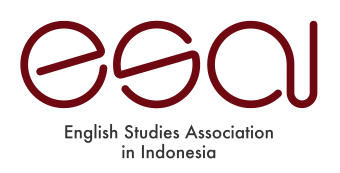INDONESIAN EFL STUDENTS’ USE OF TECHNOLOGIES FOR SELF-DIRECTED LEARNING IN ACCOMPLISHING ACADEMIC ENGLISH WRITING TASKS
Abstract
Keywords
Full Text:
PDFReferences
Adil, M. (2021). Top 15 reasons why the internet is good for students in education. Retrieved from: https://adilblogger.com/reasons-internet-good-students-education/
Beard, J. (2010). SDL timeline. Retrieved from: http://sdlearning.pbworks.com/w/page/1899125/SDL%20Timeline
Bhatia, M. (2018). Your guide to qualitative and quantitative data analysis methods. Retrieved from: https://humansofdata.atlan.com/2018/09/qualitative-quantitative-data-analysis-methods/#:~:text=The%20two%20most%20commonly%20used,descriptive%20statistics%20and%20inferential%20statistics.
Bilqis. (2010). Karakteristik belajar mandiri. Retrieved from: https://lutfizulfi.wordpress.com/2010/08/08/karakteristik-belajar-mandiri/
Boulmerka, S. (2016). Internet Use in EFL Classrooms: An Investigation of Teachers‘Attitudes and Concerns in the Teacher Training School of Constantine [Doctorate thesis, Frères Mentouri University Constantine]. Retrieved from: https://bu.umc.edu.dz/theses/anglais/BOU1395.pdf
Braun, V. & Clarke, V. (2012) Thematic analysis. In H. Cooper, P. M. Camic, D. L. Long, A. T. Panter, D. Rindskopf, & K. J. Sher (Eds), APA handbook of research methods in psychology, Vol. 2: Research designs: Quantitative, qualitative, neuropsychological, and biological (pp. 57-71). Washington, DC: American Psychological Association.
Cheng, L. (2014). The use of web-based self-directed learning for Mandarin study. Excellence in Education Journal, 3(1). Retrieved from: https://www.researchgate.net/publication/328031589_The_Use_of_Web-Based_Self-Directed_Learning_for_Mandarin_Study
Dewi, D. N., Irmawati, D. K., & Asri, T. M. (2020). Investigating EFL teachers' barriers
of using internet application at university level. Journal of English Educators Society, 5(1). Retrieved from: https://journal.umsida.ac.id/index.php/jees/article/view/375
Dörnyei, Z. (2007). Research methods in applied linguistics: Quantitative, qualitative, and mixed methodologies. Oxford University Press.
EAPFoundation.com. (2021). What is academic writing? [Video]. YouTube. Retrieved from: https://www.youtube.com/watch?v=Cq4J8bPBcck
Efriana, L. (2021). Problems of online learning during Covid-19 pandemic in EFL classroom and the solution. JELITA: Journal of English Language Teaching and Literature, 2(1). Retrieved from: https://jurnal.stkipmb.ac.id/index.php/jelita/article/view/74
Farrah, M., & Al-Bakry, G. H. (2020). Online learning for EFL students in Palestinian universities during Corona pandemic: Advantages, challenges and solutions. Indonesian Journal of Learning and Instruction, 3(2). Retrieved from: https://journal.uniku.ac.id/index.php/IJLI/article/view/3677
Farrell, S. (2016). Open-ended vs. closed-ended questions in user research. Retrieved from: https://www.nngroup.com/articles/open-ended-questions/
Ghahri, F., Hashamdar, M., & Mohamadi, Z. (2015). Technology: A better teacher in writing skill. Theory and Practice in Language Studies, 5(7). Retrieved from: https://www.researchgate.net/publication/282234778_Technology_A_Better_Teacher_in_Writing_Skill
Haqien, D., & Rahman, A. A. (2020). Pemanfaatan Zoom Meeting untuk proses pembelajaran pada masa pandemic Covid-19. SAP (Susunan Artikel Pendidikan), 5(1). Retrieved from: https://journal.lppmunindra.ac.id/index.php/SAP/article/viewFile/6511/3217
Jamalifar, G., & Chalak, A. (2014). The use of internet in English language learning: Practices, attitudes and challenges of the learners. ADVANCES IN ENGLISH LANGUAGE AND LITERATURE (AELL), 1(2). Retrieved from: https://www.researchgate.net/publication/263280738_The_Use_of_Internet_In_English_Language_Learning_Practices_Attitudes_and_Challenges_of_The_Learners
Kapur, R. (2019). Significance of self-directed learning. Retrieved from: https://www.researchgate.net/publication/335096519_Significance_of_Self-Directed_Learning
Kasworm, C. E. (1983). An examination of self-directed learning contracts as an instructional strategy. Innovative Higher Education, 8(1). Retrieved from: https://booksc.org/book/6325921/5a100a
Knowles, M. S. (1975). Self-Directed Learning: A Guide for Learners and Teachers. Follett Publishers. Retrieved from: https://id1lib.org/book/6036566/57c328
Krishnan, I. A., Ching, H. S., Ramalingam, S. J., Maruthai, E., Kandasamy, P., De Mello, G., Munia, S., & Ling, W. W. (2020). Challenges of learning English in 21st century: Online vs. traditional During Covid-19. Malaysian Journal of Social Sciences and Humanities (MJSSH), 5(9). Retrieved from: https://www.researchgate.net/publication/343987475_Challenges_of_Learning_English_in_21st_Century_Online_vs_Traditional_During_Covid-19
Lasfeto, D. B., & Ulfa, S. (2020). The relationship between self-directed learning and students’ social interaction in the online learning environment. JOURNAL OF E-LEARNING AND KNOWLEDGE SOCIETY, 16(2). Retrieved from: https://www.je-lks.org/ojs/index.php/Je-LKS_EN/article/view/1135078/1203
Monica, J., & Fitriawati, D. (2020). Efektivitas penggunaan aplikasi Zoom sebagai media pembelajaran online pada mahasiswa saat pandemi Covid-19. Jurnal Communio: Jurnal Ilmu Komunikasi, 9(2). Retrieved from: https://ejurnal.undana.ac.id/JIKOM/article/view/2416
Nalurita, S. (2021). Pemanfaatan aplikasi Google Meet pada mata kuliah Teknik proyeksi bisnis semester gasal tahun pembelajaran 2020/2021 di Universitas Dirgantara Marsekal Suryadarma (UNSURYA) (Studi pada mahasiswa prodi Manajemen Kelas G). Jurnal Ilmiah Manajemen Surya Pasca Scientia, 10(1). Retrieved from: https://journal.universitassuryadarma.ac.id/index.php/jimspc/article/view/593
Ors, M. (2018). The self-directed learning readiness level of the undergraduate students of midwife and nurse in terms of sustainability in nursing and midwifery education. Sustainability, 10(3574). Retrieved from: https://www.researchgate.net/publication/328154117_The_Self-Directed_Learning_Readiness_Level_of_the_Undergraduate_Students_of_Midwife_and_Nurse_in_Terms_of_Sustainability_in_Nursing_and_Midwifery_Education/references
Oxford, R. M. N. (2004). Effects of technology-enhanced language learning on second language composition of university-level intermediate Spanish students [Doctoral thesis, University of North Texas]. Retrieved from: https://digital.library.unt.edu/ark:/67531/metadc4688/m2/1/high_res_d/dissertation.pdf
Prabandari, A. I. (2021). Manfaat mendengarkan music saat belajar, meningkatkan mood dan motivasi. Retrieved from: https://www.merdeka.com/jateng/manfaat-mendengarkan-musik-saat-belajar-meningkatkan-mood-dan-motivasi-kln.html
Pratama, Y., Boeriswati, E., & Murtadho, F. (2020). The use of Adobe Animate as a new technology in teaching academic essay writing in Darma Persada University. Journal GEEJ, 7(1). Retrieved from: https://ejournal.bbg.ac.id/geej/article/view/1001/955
Radhakrishnan, J. (2017). Strategies for technology enhanced language learning (TELL) in language classes. International Journal of Interdisciplinary Research in Arts and Humanities (IJIRAH), 2(1). Retrieved from: https://zenodo.org/record/545982#.YWKvZtpBw2w
Rahardjo, D., Sumardjo., Lubis, D. P., & Harijati, S. (2016). Internet access and usage in improving students’ self-directed learning in Indonesia open university. Turkish Online Journal of Distance Education, 17(2). Retrieved from: https://www.researchgate.net/publication/299598673_Internet_Access_and_Usage_in_Improving_Students'_Self-Directed_Learning_in_Indonesia_Open_University
Rahmawati, F. (2016). E-learning implementation: Its opportunities and drawbacks perceived by EFL students. Journal of Foreign Language, Teaching & Learning, 1(1). Retrieved from: https://journal.umy.ac.id/index.php/FTL/article/view/2022
Riasati, M. J., Allahyar, N., & Tan, K-E. (2012). Technology in language education: Benefits and barriers. Journal of Education and Practice, 3(5). Retrieved from: https://www.academia.edu/1547372/11_Technology_in_Language_Education_Benefits_and_Barriers
Sandolo, L. (2010). How can the use of Technology enhance writing in the classroom? Education Masters. Retrieved from: https://fisherpub.sjfc.edu/cgi/viewcontent.cgi?article=1195&context=education_ETD_masters#:~:text=The%20results%20indicated%20that%20technology,and%20it%20initiates%20self%20revisions.
Saragih, G. (2017). Pendidikan orang dewasa untuk mereka yang belum dewasa. Retrieved from: https://www.kompasiana.com/guntur_saragih/58fc5780ca23bd963bbd1c05/pendidikan-orang-dewasa-untuk-mereka-yang-belum-dewasa
Song, L., & Hill, J. R. (2007). A conceptual model for understanding self-directed
learning in online environments. Journal of Interactive Online Learning, 6(1). Retrieved from: https://www.researchgate.net/publication/250699716_A_Conceptual_Model_for_Understanding_Self-Directed_Learning_in_Online_Environments
Steinhilber, B. (2018). 3 types of motivation that can inspire you to do anything. Retrieved from: https://www.nbcnews.com/better/health/3-types-motivation-can-inspire-you-do-anything-ncna781826
Tereseviciene, M., Volungeviciene, A., Zydziunaite, V., Kaminskiene, L., Rutkiene, A., Trepule, E., & Daukilas, S. (2015). Technologijomis grindžiamas mokymas ir mokymasis organizacijoje. Versus Aureus. Retrieved from: https://www.researchgate.net/publication/281289157_Technologijomis_grindziamas_mokymas_ir_mokymasis_organizacijoje
Tracy, S. J. (2020). Qualitative Research Methods: Collecting Evidence, Crafting Analysis, Communicating Impact (2nd ed.). John Wiley & Sons/Blackwell. Retrieved from: https://en.id1lib.org/book/5333283/c1c35b
Turan, M. B., & Koc, K. (2018). The impact of self-directed learning readiness on critical thinking and self-efficacy among the students of the School of Physical Education and Sports. Sciedu Press, 7(6). Retrieved from: https://files.eric.ed.gov/fulltext/EJ1199445.pdf
Umam, C., Aini, N., & Rahayu, W. S. (2019). Indonesian EFL learners’ perception on the internet use in language learning. ELITE JOURNAL: Journal of English Linguistics, Literature, and Education, 2(1). Retrieved from: http://repository.iainkediri.ac.id/30/
Zhou, Y., & Wei, M. (2018). Strategies in technology-enhanced language learning. SSLLT, 8(2). Retrieved from: https://files.eric.ed.gov/fulltext/EJ1183997.pdf.
DOI: http://dx.doi.org/10.30813/jelc.v15i1.5623
Refbacks
- There are currently no refbacks.



2.jpg)



